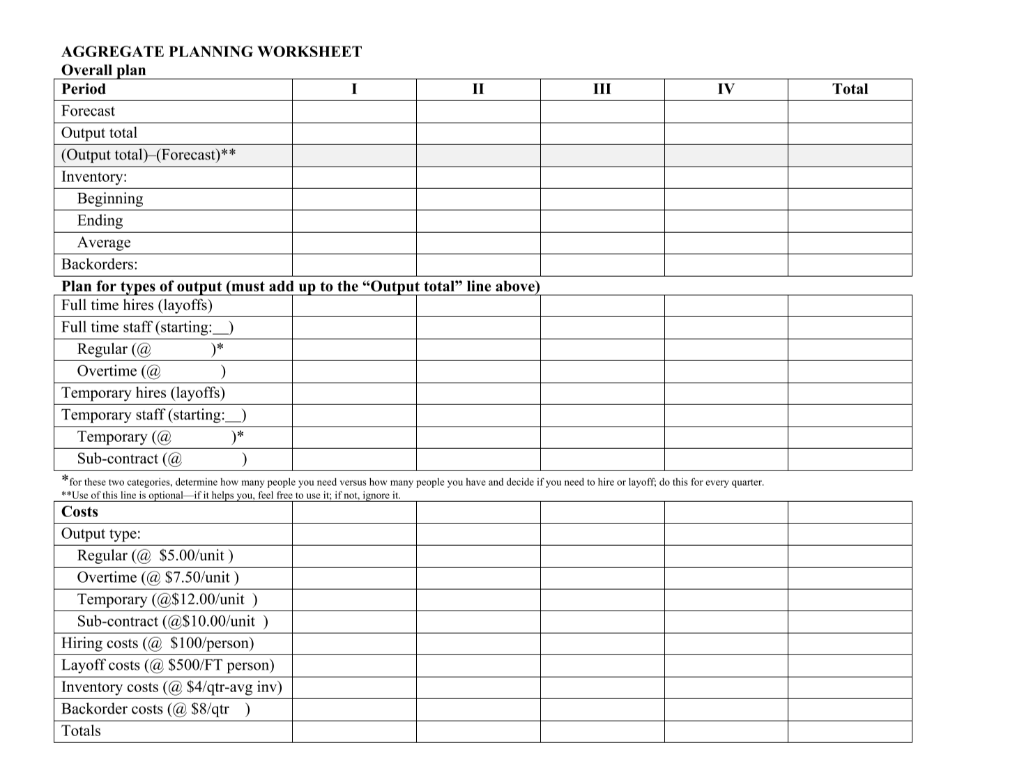Question
3- The V.P of Marketing is not all that happy with the large volume of backorders in your plan from question 1A . She asks
3- The V.P of Marketing is not all that happy with the large volume of backorders in your plan from question 1A . She asks that you develop a plan that requires no backorders at any time during the year. The V.P. of manufacturing says that he will insist that any such plan specify level output each quarter. The V.P. of Finance states that you no longer need to have a Qtr. IV ending inventory of zero but it should be as low as possible.
Use the original demand data, beginning inventory, etc. from problem 1. Develop a plan that will meet the requirements of all three V.P.'s.
4- On Dec. 22 the V.P. Finance informs you that the availability of capital will be extremely tight next year. As a consequence, he asks you to develop a radically different type of aggregate plan based on a "Chase" strategy. Ending inventory and backorders is to be zero at the end of each quarter. The V.P. Manufacturing says he realizes this type of strategy will require him to abandon his beloved "level" strategy and for you to vary the total output rate from one quarter to another. The productivity planning factors for each type of output are repeated here (note that there are some limits in a couple of the categories).
| Option | Productivity | Limitations |
| Full-Time Employees | 500 units/worker/qtr |
|
| Overtime (FTE) | Up to 200 units/worker/qtr |
|
| Subcontract |
| Up to 5000 units/qtr |
| Part-time Workers | 400 units/worker/qtr | Up to 25 workers/qtr |
Finally, the Personnel Manager informs you that, due to end of the year retirements, only 36 (not 44) fulltime employees will be on the payroll as of Jan 2.
Using the original demand and beginning inventory information for problem 1, develop a "chase" plan, following the guidelines noted above.
Previous Information -
MBA Inc. assembles lawn mowers and snow blowers from subassemblies and component parts provided by reliable vendors. Both products (end items) utilize the same small engines, many of the same parts and require the same assembly time and employee labor skills. On December 20, the Production Planning Committee of MBA Inc. is due to adopt an aggregate plan for the coming year. The available planning information is as follows: Information: Demand Forecasts
Quarter Lawn Mowers Snow Blowers Q - I 10,000 9,000 Q - II 15,000 7,000 Q - III 16,000 19,000 Q - IV 3,000 10,000 Quarter - I Beginning Inventory: Mowers 600; blowers 400 Output and Costs: Regular Time $5.00 per unit Overtime $7.50 per unit Subcontract $10.00 per unit Part Time $12.00 per unit Inventory $4.00 per unit per quarter based on avg. inventory during each quarter Backorders $8.00 per unit per period (based on backorders at end of period) Hiring $100.00 per employee (Full-Time or Part-Time) Layoff $500.00 per employee (no cost if Part-Time) Production Rates:
Regular 500 units per Full-Time employee per quarter (of either unit) Overtime up to 200 units per Full-Time employee per quarter (of either unit) Part Time 400 units per Part Time employee per quarter (of either unit) Production work force:
As of the first of the year, the production work force consists of 44 Full-Time employees. Additional Assumptions:
1) Part Time employees may not work overtime
2) Assume 100% utilization of Full-Time employees on regular time and of Part Time employees at all times (i.e., all such employees on the payroll during a period produce at the rates shown under Production Rates).
3) Overtime utilization of Full-Time employees can be on an as needed basis subject to the limitation on maximum overtime output shown under Production Rates.
Given all of this planning information, develop a series of aggregate plans to meet the criteria presented in the following series of problems. All plans must include full costs and hiring/layoff actions, as needed. Show all plans using one of the worksheets at the end of this document.

Total AGGREGATE PLANNING WORKSHEET Overall plan Period 1 II IV Forecast Output total (Output total)-(Forecast)** Inventory Beginning Ending Average Backorders: Plan for types of output (must add up to the "Output total" line above) Full time hires (layoffs) Full time staff (starting: ) Regular (@ )* Overtime (@ ) Temporary hires (layoffs) Temporary staff (starting:_) Temporary (@ )* Sub-contract (@ ) *for these two categories, determine how many people you need versus how many people you have and decide if you need to hire or layoff, do this for every quarter. **Use of this line is optional if it helps you, feel free to use it; if not, ignore it. Costs Output type: Regular (@ $5.00/unit) Overtime (@ $7.50/unit Temporary (@$12.00/unit) Sub-contract (@$10.00/unit) Hiring costs @ $100/person) Layoff costs @ $500/FT person) Inventory costs @ $4/qtr-avg inv) Backorder costs @ $8/qtr) Totals Total AGGREGATE PLANNING WORKSHEET Overall plan Period 1 II IV Forecast Output total (Output total)-(Forecast)** Inventory Beginning Ending Average Backorders: Plan for types of output (must add up to the "Output total" line above) Full time hires (layoffs) Full time staff (starting: ) Regular (@ )* Overtime (@ ) Temporary hires (layoffs) Temporary staff (starting:_) Temporary (@ )* Sub-contract (@ ) *for these two categories, determine how many people you need versus how many people you have and decide if you need to hire or layoff, do this for every quarter. **Use of this line is optional if it helps you, feel free to use it; if not, ignore it. Costs Output type: Regular (@ $5.00/unit) Overtime (@ $7.50/unit Temporary (@$12.00/unit) Sub-contract (@$10.00/unit) Hiring costs @ $100/person) Layoff costs @ $500/FT person) Inventory costs @ $4/qtr-avg inv) Backorder costs @ $8/qtr) Totals
Step by Step Solution
There are 3 Steps involved in it
Step: 1

Get Instant Access to Expert-Tailored Solutions
See step-by-step solutions with expert insights and AI powered tools for academic success
Step: 2

Step: 3

Ace Your Homework with AI
Get the answers you need in no time with our AI-driven, step-by-step assistance
Get Started


